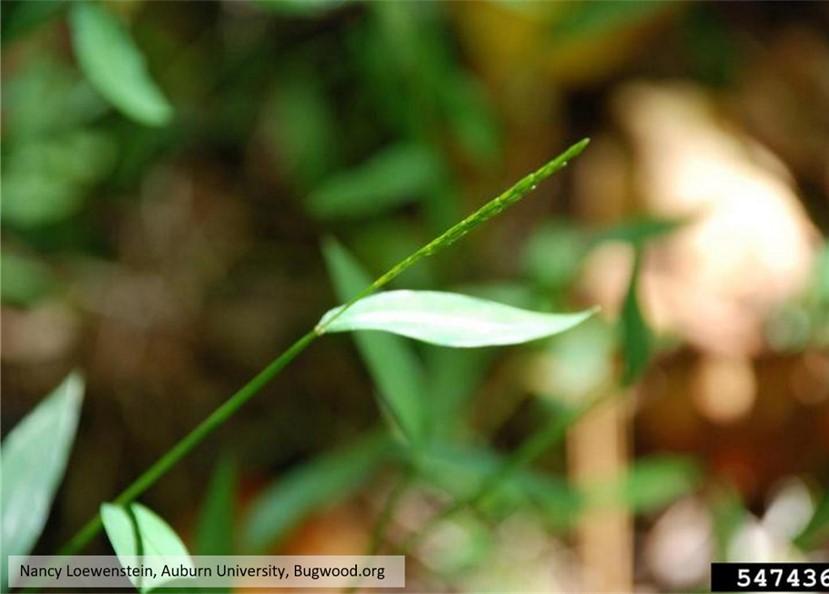Japanese Stiltgrass Identification and Management

Now is the time to scout pasture and hay fields for Japanese stiltgrass and take note of its locations. This invasive grass is typically seen in wooded areas, but unfortunately has been creeping into fields. Once the seed heads start to form in another month or two, you’ll want to have the mower ready.
The leaves of Japanese stiltgrass are wider and shorter than most of our common pasture grasses. There is also a distinctive silvery midvein that is slightly off-center from the middle of the leaf (Figure 1). Japanese stiltgrass also has a shallow root system, so it can be pulled out easily. For more information on how to identify stiltgrass, visit USDA’s National Invasive Species Information Center website.
The one (and only one) positive thing about this invasive is that it is an annual, so there’s no perennial root system to contend with. However, as an annual, stiltgrass spreads by seeds. Seed heads start to form in mid-September through October. Once they are visible (Figure 2), mow the area to prevent the seeds from maturing and becoming viable. The stiltgrass will likely not have enough time to regrow and set more seeds before the first frost.
Herbicides are another option. A broad spectrum herbicide such as glyphosate can be used as a spot-spray. If using glyphosate, the optimum application timing is late spring through summer (before seed heads are formed). Follow the label for rates and restrictions. (With Roundup®, for example, do not apply to more than one-tenth of any acre, and wait 7 days after application before grazing or making hay.)
Prowl H2O® is a pre-emergent herbicide that contains the active ingredient pendimethalin. It is labeled for applications on established grass that has at least 6 tillers; however, its reseeding restrictions make it a challenge to use in grass crops. The reseeding restrictions, or the waiting period before reseeding, are 10 months for pasture grasses and 6 months for alfalfa. (Remember, Prowl H2O is a pre-emergent herbicide, so it will prevent grass and alfalfa seeds from germinating, too.) As a pre-emergent, it must be applied before the stiltgrass emerges, which can happen beginning when the soil temperature is about 50 degrees F; this means that Prowl H2O will need to be applied earlier than when we may be used to with other summer annual weeds. If Prowl H2O is used, manage the bare areas so that weeds cannot take over before reseeding can be done.
Once a control method is implemented, reseed bare areas so they are not left for stiltgrass and other weeds to fill back in. In order to keep your forage grasses competitive, use practices such as proper mowing height, proper grazing and stocking rates, and apply nutrients and lime at the proper rate when needed.
This article appears in August 2022, Volume 13, Issue 5 of the Agronomy news.
 English
English العربية
العربية Български
Български 简体中文
简体中文 繁體中文
繁體中文 Hrvatski
Hrvatski Čeština
Čeština Dansk
Dansk Nederlands
Nederlands Suomi
Suomi Français
Français Deutsch
Deutsch Ελληνικά
Ελληνικά हिन्दी
हिन्दी Italiano
Italiano 日本語
日本語 한국어
한국어 Norsk bokmål
Norsk bokmål Polski
Polski Português
Português Română
Română Русский
Русский Español
Español Svenska
Svenska Català
Català Filipino
Filipino עִבְרִית
עִבְרִית Bahasa Indonesia
Bahasa Indonesia Latviešu valoda
Latviešu valoda Lietuvių kalba
Lietuvių kalba Српски језик
Српски језик Slovenčina
Slovenčina Slovenščina
Slovenščina Українська
Українська Tiếng Việt
Tiếng Việt Shqip
Shqip Eesti
Eesti Galego
Galego Magyar
Magyar Maltese
Maltese ไทย
ไทย Türkçe
Türkçe فارسی
فارسی Afrikaans
Afrikaans Bahasa Melayu
Bahasa Melayu Kiswahili
Kiswahili Gaeilge
Gaeilge Cymraeg
Cymraeg Беларуская мова
Беларуская мова Íslenska
Íslenska Македонски јазик
Македонски јазик יידיש
יידיש Հայերեն
Հայերեն Azərbaycan dili
Azərbaycan dili Euskara
Euskara ქართული
ქართული Kreyol ayisyen
Kreyol ayisyen اردو
اردو বাংলা
বাংলা Bosanski
Bosanski Cebuano
Cebuano Esperanto
Esperanto ગુજરાતી
ગુજરાતી Harshen Hausa
Harshen Hausa Hmong
Hmong Igbo
Igbo Basa Jawa
Basa Jawa ಕನ್ನಡ
ಕನ್ನಡ ភាសាខ្មែរ
ភាសាខ្មែរ ພາສາລາວ
ພາສາລາວ Latin
Latin Te Reo Māori
Te Reo Māori मराठी
मराठी Монгол
Монгол नेपाली
नेपाली ਪੰਜਾਬੀ
ਪੰਜਾਬੀ Afsoomaali
Afsoomaali தமிழ்
தமிழ் తెలుగు
తెలుగు Yorùbá
Yorùbá Zulu
Zulu ဗမာစာ
ဗမာစာ Chichewa
Chichewa Қазақ тілі
Қазақ тілі Malagasy
Malagasy മലയാളം
മലയാളം සිංහල
සිංහල Sesotho
Sesotho Basa Sunda
Basa Sunda Тоҷикӣ
Тоҷикӣ O‘zbekcha
O‘zbekcha አማርኛ
አማርኛ Corsu
Corsu Ōlelo Hawaiʻi
Ōlelo Hawaiʻi كوردی
كوردی Кыргызча
Кыргызча Lëtzebuergesch
Lëtzebuergesch پښتو
پښتو Samoan
Samoan Gàidhlig
Gàidhlig Shona
Shona سنڌي
سنڌي Frysk
Frysk isiXhosa
isiXhosa